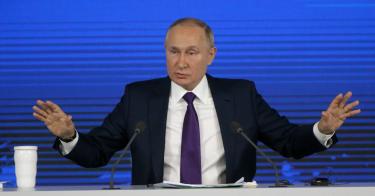Earlier this week, a winter storm briefly trapped U.S. President Joe Biden aboard Air Force One. Thanks to Russian President Vladimir Putin, that hemmed-in feeling may have been uncomfortably familiar. Seemingly intent on forcing a diplomatic showdown with the West, the Russian strongman has arranged his pieces in such a way as to ensure he comes away with a king’s ransom.
Putin has already stationed some 100,000 additional troops near Ukraine, a number that could nearly double should he decide to open a new front. His terms for easing tensions are more like those of an armed robber demanding all the cash in the register rather than a negotiator staking out of a serious position. He has since warned of a “complete rupture” of relations if the West counters a further incursion into Ukraine with additional sanctions.
Upping the stakes further, Russia and Belarus last week announced a new round of war games planned for February/March. Belarus President Alexander Lukashenko had already announced his willingness to host Russian nuclear weapons.
Lukashenko’s attempt to destabilize Latvia, Lithuania, and Poland with a flood of refugees continues apace. The humanitarian crisis created by his hybrid warfare remains an ongoing headache for those nations. Poland for its part, continues to build a wall to secure its border, and Lithuania has begun paying migrants to return home, Belarus will keep the situation simmering.
>>> Seven Actions Russia Must Take Before Receiving Another Meeting with NATO
Meanwhile, Putin is playing the energy card, cutting overland gas deliveries via Ukraine to their lowest levels in two years. This caused European gas prices to 30% jump 30%. Putin can afford to be patient while waiting for Nord Stream II certification, but this gives him leverage to ensure the current suspension of certification proceedings doesn’t become permanent.
In the Balkans, Russia continues to fan the flames of dismemberment, so ably lit by Republika Srpska’s Milorad Dodik, who is trying to create an independent army and intelligence service for Bosnia Serbs.
Why is Putin so intent on forcing a showdown now? Clearly, he believes the time is ripe.
The Biden administration has sent all the wrong signals since day one. After unilaterally capitulating on Nord Stream II, it engineered the humiliating and disorderly retreat from Afghanistan. Then, throughout the summer and fall, it sent a steady stream of envoys to Moscow, signaling a near desperate desire for accommodation.
The diplomatic pleadings will continue next week with a U.S.-Russia bilateral and the adjacent meetings of the NATO-Russia Council (NRC) and the Organization for Security and Cooperation in Europe (OSCE). Under the current conditions, these high-level discussions are a mistake.
Putin’s list of demands for discussion are so outlandish they cannot possibly be met. Furthermore, it’s impossible to see how any reciprocal actions which the West would surely demand (say the return of Crimea to Ukraine) would ever be domestically palatable for the Kremlin.
Will Putin’s pressure campaign cow the West into offering concessions without reciprocity? Or will his absurd demands ensure the failure of negotiations, giving him a pretext for launching a new offensive against Ukraine?
Either way, it’s hard to see how the Biden administration emerges unscathed from the box it has willingly walked itself into.
What then to expect from next week’s slurry of meetings? Not much. I believe Russia’s opening salvo likely poisoned the well for any sort of agreement.
If events in Kazakhstan continue to snowball, they could convince the Kremlin not to move further in Ukraine, but that would come at some risk for Putin. Domestically, he’s committed to an outcome: either further territorial gains in Ukraine, or a prize offered up by the West in exchange for de-escalation.
>>> Sensing Western Weakness, Putin Gathers Strength in Europe
Putin has constructed a diplomatic box to squeeze and divide the west. Biden should never have stepped into it, but that’s water over the dam, now.
What remains is Western resolve. The U.S. must approach next week’s meetings with Russia from a position of strength. It must: pledge to install a long-overdue permanent military presence in an eastern European NATO ally; refuse to cave on NATO’s open-door policy; calmly and resolutely refute Russian propaganda around NATO encirclement; make it known that further incursions will set off a concerted effort to target oligarch money stashed away in the West; and maintain a united front with our European allies.
Putin sees the U.S. under President Biden as weak. He must come away convinced that the costs of any further aggression against Ukraine have risen and now outweigh the domestic embarrassment of backing off the high noon drama of his own creation.
This piece originally appeared in 19fortyfive



